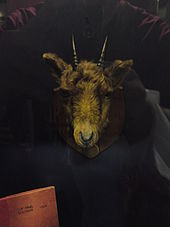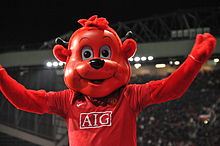- Manchester United F.C. mascots
-
This is a chronological list of Manchester United F.C mascots from their foundation as Newton Heath F.C. in 1878. The current club mascot is "Fred the Red", an anthropomorphic "Red Devil", after the club's nickname, the Red Devils.
Contents
Michael the Bank Street Canary (1890s)
During the 1890s, readers of Newton Heath F.C. match programmes may have seen advertisements to hear "Michael the Bank Street Canary sing," for a nominal fee. However, Michael was not able to sing, and nor was he a canary. In actuality, Michael was a goose and was an unwitting participant in the money-making schemes that the club were using during their financial difficulties.
Understandably, the fans who had paid good money to hear a canary sing were rightfully unimpressed by Michael's tuneless honk. Then, one Christmas, Michael mysteriously disappeared, never to be seen again, believed to have been served as a dissatisfied fan's Christmas dinner.
Major the Saint Bernard dog (1902–1905/06)
Major was the prized Saint Bernard of Newton Heath's club captain and full-back, Harry Stafford, and played a pivotal role in the changing of the club's name, colours and stadium. Still in financial difficulty, Stafford would send his dog around the crowd with a collection box on its collar in the hope of bringing in much-needed extra funds. Then, in 1901, the club held a fund-raising bazaar, at which Major did his usual rounds with the collection box. However, the bazaar was a "rank failure", as described by the archives of the Topical Times, and by the end of it, Major had gone missing.
Stafford went out looking for his prize dog, and eventually found him in the possession of local brewer John Henry Davies, who wished to keep Major as a pet for his daughter. Stafford priced Major at a £500 investment in Newton Heath F.C. in order to guarantee the club's financial security for the immediate future. Davies was appointed chairman, and eventually renamed the club as Manchester United F.C. in 1902, changing the club colours to red and white.
Major was eventually retired as club mascot during the 1905-06 season. Whether this was due to his demise or just old age is unknown, but what is certain is that Major will be forever remembered as one of the most important mascots the club has ever had.
Billy the Goat (1905/06–1909)
Following the retirement of Major, the club decided to adopt a new mascot. Half-back Charlie Roberts had recently been given a goat by The Bensons, a theatre company. Why Roberts was given a goat, and why a theatre company gave it to him, is unknown, but he (imaginatively) named the goat "Billy", and Billy the Goat became the third club mascot. Like Major before him, Billy was also paraded around the ground before home games.
Interestingly, the records show that Billy travelled to ale houses with the team on numerous occasions, sometimes having the odd tipple. However, it was Billy's taste for alcohol that would cause him to meet his demise. After the 1909 FA Cup Final win over Bristol City, Billy took part in the post-match celebrations with the players, but drank too much champagne and died of alcohol poisoning soon after.
"Hoppy" Thorne, the One-legged Wonder (late 1930s–late 1940s)
William "Hoppy" Thorne was a British soldier during the First World War. He was too young to join the army at the start of the war, but nonetheless signed up under a false name. He somehow lost a leg in combat, and was marked as an invalid on his return to Britain. This status meant that few employers would give him any work, but he managed to find work at Old Trafford, sweeping up after home matches and operating the scoreboard at Reserve games.
Hoppy became well-known amongst the players, but what made him famous to the fans were his pre-match entertainments. Before home matches, he would strip off his clothes, down to his running gear, jump over the fence around the playing surface, and hop or run around the pitch, depending on whether he'd attached his false leg or not.
However, Hoppy's tenure as club mascot came to an end towards the end of the 1940s. He failed to receive tickets for the 1948 FA Cup Final in the members' ballot, and as a result, an irreconcilable rift formed between him and the club.
Jack Irons (late 1940s–1963)
John Thomas "Jack" Irons was the Manchester United mascot for nigh on fifteen years. He would parade around the pitch in a red-and-white dinner suit before kick-off, holding his red-and-white umbrella while signing autographs and greeting the fans, and even tossing the coin for the kick-off on occasion.
How and when Irons became the club mascot is unknown, but according to the Club Minutes Book for 9 May 1963, Irons "had decided to retire at the end of the present season [1962-63]. It was decided to make a presentation to him up to the value of £25-0-0d." He made a one-match comeback for the 1968 European Cup Final, but then disappeared into obscurity, though he presumably continued to support the club until the day he died.
Frank Hilton and Ronnie McWilliams both had spells "under the umbrella", but the practise of the "friendly mascot" had to be abandoned soon after, due to the rise of hooliganism in the United Kingdom.
Fred the Red (1994–present)
The current Manchester United mascot, Fred the Red represents the nickname of the club, i.e., The Red Devils.
He usually dances in front of the crowd before matches. Fred the red was voted the most popular mascot in 'Match' magazine in 2011. He high fives all the players as they leave the tunnel before matches.
References
- Wylie, Mark; Moors, Gillian; Struthers, Nicola; Liverman, Darren (November 1999). "Mascot mania". Manchester United: the official magazine of Manchester United Football Club (83): pp. 28–30. "Heard the one about the drunken goat, the non-canary and the one-legged man?"
Manchester United Football Club Players · Managers · Reserves & Academy · Records & statistics · Honours · Current season History Munich air disaster Home stadium North Road (1878–1893) · Bank Street (1893–1910) · Old Trafford (1910–present) · Stretford End · Sir Matt Busby WayTraining ground Players Rivalries Supporters Media Related articles  Book:Manchester United F.C. ·
Book:Manchester United F.C. ·  Category:Manchester United F.C. ·
Category:Manchester United F.C. ·  Portal:Association football ·
Portal:Association football ·  Manchester United task force ·
Manchester United task force ·  Commons:Manchester UnitedCategories:
Commons:Manchester UnitedCategories:
Wikimedia Foundation. 2010.


